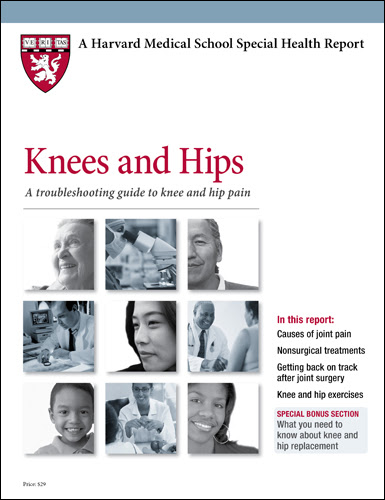
Surgery-free pain relief for hips and knees

Image: Guillermo Iosio/iStock
Hip and knee pain can keep you from the activities you love, as well as make routine tasks difficult. But there are many ways to get you moving again pain-free, without surgery. Here are some of the treatments that can help.
Ultrasound, phonophoresis, and iontophoresis
Therapeutic ultrasound is a simple procedure that uses sound waves to increase blood flow, relax muscle spasms, and aid healing. The therapist applies gel to your skin and moves an ultrasound wand over your skin around the painful area. In a special ultrasound technique called phonophoresis, medication (often hydrocortisone) is added to the gel. In a survey of orthopedic physical therapists, more than half said they would use ultrasound and phonophoresis to reduce soft-tissue inflammation (in tendinitis or bursitis, for example). These techniques are also used to manage pain, heal tissue, and help muscles stretch.
Get your copy of Knees and Hips
|
Iontophoresis uses electrical currents to speed the delivery of medication to damaged tissue, or simply to reduce muscle spasms and related irritation. Patches similar to Band-Aids are placed on the skin, and a painless, low-level current is applied for about 10 to 15 minutes. You may feel warmth or tingling during the treatment.
Therapeutic exercise
Strengthening the muscles around a damaged knee or hip can help reduce stress on a joint. For example, your hips have to do less work to support your body weight if your quadriceps, gluteals, hamstrings, and abdominal muscles are strong. A strong quadriceps can also take on some of the shock-absorbing work of the meniscus or cartilage in the knee. The proper balance of strength in the muscles can hold the joint in the most functional and least painful position. Flexibility exercises (to stretch and relax specific muscles) are also an important part of an exercise plan to improve joint function.
Gait retraining
Knee and hip problems can disrupt your normal walk by causing pain, restricting joint movement, or weakening muscles. And a person's normal pattern of standing, walking, or running may invite joint problems. It may take many years of walking with an abnormal gait before joint injury occurs. A physical therapist can analyze your gait and help you learn to move more efficiently. Initially, the "normal" gait may feel odd. It can take practice and continued instruction before it becomes comfortable, but it will eventually become natural for you. Physical therapists may also suggest a change in shoes or ways to strengthen muscles that can help restore a more aligned gait.
For more on strategies for pain-free knees and hips, plus a Special Bonus Section on knee and hip replacement, buy Knees and Hips, a Special Health Report from Harvard Medical School.
Does double knee surgery make sense for you? |

Image: iStock
The idea of having a knee replaced is daunting. But what if both of your knees need repairing? Is one visit to the operating room better than two?
If you are otherwise in good health, it's a conversation worth having with your doctor and rehabilitation team. There are some benefits to replacing both joints during a single surgery (called simultaneous replacement). These include undergoing anesthesia only once, fewer days in the hospital, and only one (albeit prolonged) rehabilitation that lets you resume normal activities sooner than two separate ones.
Simultaneous replacement can also be a good option if the condition of your joints is so poor that replacing only one joint would still leave you unable to function during physical therapy, thereby slowing your recovery. That said, having two separate operations several months apart (called staged replacement) reduces the frequency of some complications.
In analyzing thousands of knee replacement procedures, Mayo Clinic researchers found that people who have simultaneous knee replacements are more likely to develop dangerous blood clots or die within 30 days than those who have single-knee surgery, although such complications are rare overall. But because the possibility is there, people over 80 and those with cardiovascular or lung disease are usually offered staged procedures. If you have any significant medical risks, you are probably better off having two separate operations.
Because you spend less time in the hospital with simultaneous joint replacement, it is somewhat less costly. But when replacement of both joints is medically necessary, Medicare and most private insurers usually cover either approach.
Whether you have one knee replaced or two, participating in a rehabilitation program will be a major factor in the success of your implant. Think of yourself as an athlete training to come back from an injury. Several times a day, you will need to perform exercises your physical therapist has recommended to restore movement in the knee joint and strengthen the surrounding muscles. In addition, ask your doctor how soon you can return to specific activities such as driving, work, sex, or sports, and what you'll need to do to achieve those goals.
For more details on your options when considering joint replacement surgery, including nonsurgical treatments, purchase Knees and Hips, a Special Health Report from Harvard Medical School.






















.jpg)












No hay comentarios:
Publicar un comentario